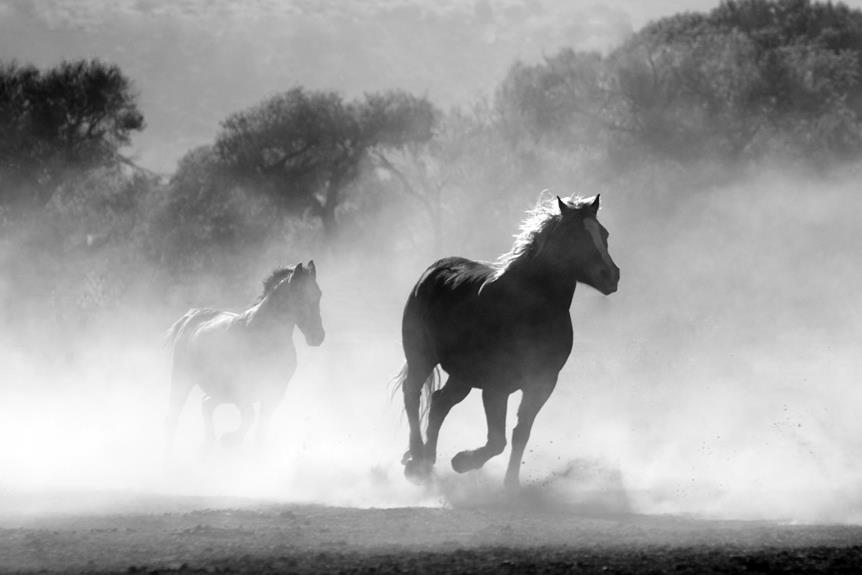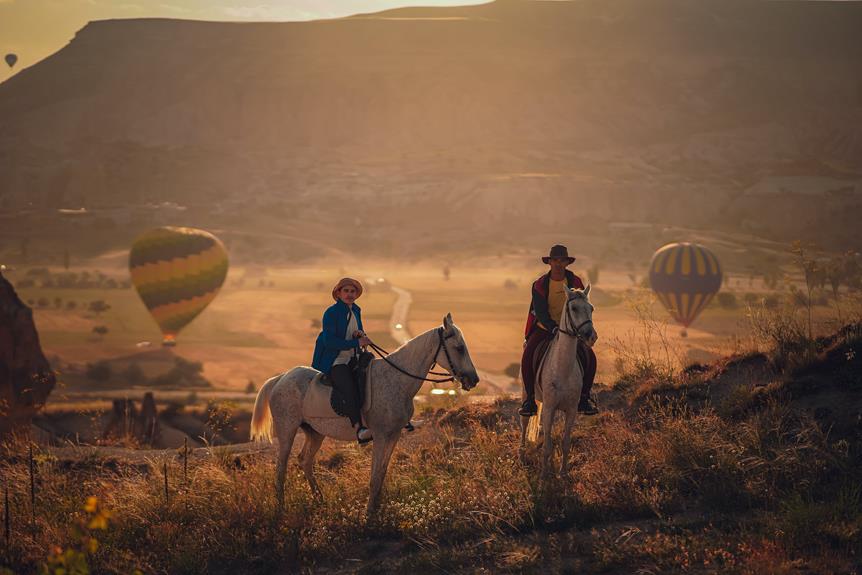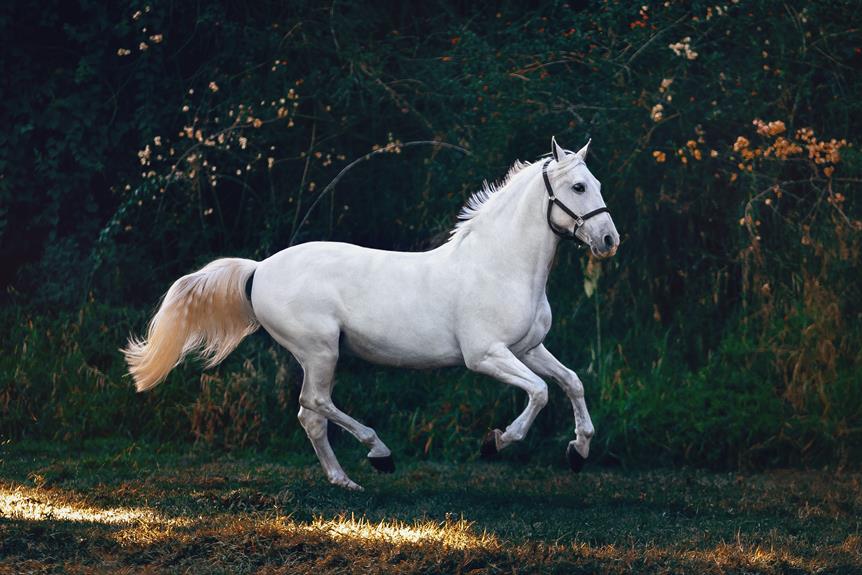Have you ever wondered what a baby horse is called? Well, let's start with the basics. A baby horse is called a foal until it reaches one year old.
But that's not all, there's actually more to it. There are specific terms for male and female foals, and their names change as they grow.
It's really fascinating how these young equines go through different stages before becoming the majestic creatures we often see.
So, if you're curious to learn more about the various names for baby horses and the intriguing characteristics they possess, keep reading. You won't want to miss out on these interesting facts!
Key Takeaways
- A baby horse is called a foal until it reaches one year old.
- Foals transition from nursing to eating solid food around three to four months of age.
- Foals lose their baby teeth and grow permanent ones at around six months.
- Regular veterinary care, proper nutrition, and a safe environment are important for the healthy development of baby horses.
Definition of a Baby Horse
A baby horse, also known as a foal, is a young horse that's typically less than a year old. The horse's age is an important factor in determining its developmental stage and care needs.
During the first few days of life, a foal is dependent on its mother for nourishment and protection. It will nurse from its dam and spend most of its time resting and exploring its surroundings.
As the foal grows older, it will start to eat solid food, such as grass and hay, in addition to nursing. This transition usually occurs around three to four months of age. It's crucial for the foal to receive proper nutrition and veterinary care during this period to support its growth and development.
At around six months, the foal will begin to lose its baby teeth and grow permanent ones. By the age of one, the foal is considered a yearling and is no longer classified as a baby horse.
Understanding the different stages of a foal's growth is essential for horse owners to provide appropriate care and training as the horse matures.
Different Names for Baby Horses
As we explore the fascinating world of baby horses, it's important to understand the different names they go by. Baby horses, or foals, have specific names depending on their age and gender. Here are the different names for baby horses:
| Age | Female | Male |
|---|---|---|
| 0-1 year | Filly | Colt |
| Over 1 year | Mare | Stallion |
| After weaning | Weanling | Weanling |
When a baby horse is born, it is called a foal. Until it reaches one year old, a female foal is called a filly, while a male foal is called a colt. Once a foal is weaned from its mother, it is referred to as a weanling. After the first year, a female horse is called a mare, and a male horse is called a stallion.
Understanding these different names for baby horses allows us to appreciate the unique stages of their development. It's fascinating to see how they grow and mature into magnificent adult horses.
Characteristics of Baby Horses
Baby horses, also known as foals, exhibit distinct characteristics that make them unique and captivating creatures. One of their most noticeable characteristics is their energy and playfulness. Foals are constantly exploring their surroundings, running and jumping with boundless enthusiasm. Their soft and fuzzy coat is another distinguishing feature. This coat will eventually be replaced with a more mature coat as they grow older.
In addition, foals have long legs in proportion to their bodies. These long legs help them develop their agility and speed at a rapid pace. Despite their small size, they can move with surprising grace and swiftness.
Foals rely on their mother's milk for nutrition and are known for their curious and inquisitive nature. They're always eager to learn and discover new things.
Another characteristic of baby horses is their strong instinct to stay close to their mother. They seek protection and guidance from their mother, who teaches them the ways of the world. This close bond provides them with a sense of security during their early stages of life.
Development and Growth of Baby Horses
After exploring the characteristics of baby horses, let's now shift our focus to the development and growth of these captivating creatures.
The development and growth of baby horses is a fascinating process to observe. From birth to adulthood, these young equines go through various stages that shape their physical and mental abilities.
At birth, foals are already able to stand and walk within a few hours. They rely on their mother's milk for nourishment, which provides essential nutrients for their growth. As they grow, foals start to eat solid food alongside nursing until they're weaned. Weaning is the process of transitioning a foal to an adult equine diet and is usually done around the third month. This promotes their independence and encourages further growth and development.
During their first year, foals experience rapid growth. They gain weight and increase in height, with their bones and muscles strengthening. By the end of their first year, foals are called yearlings. At this stage, they're still growing but have reached a significant milestone in their development.
It is important to note that the growth and development of baby horses can vary depending on factors such as breed, genetics, and nutrition. Regular veterinary care, proper nutrition, and a safe environment are crucial in ensuring the healthy development of these young equines.
Fun Facts About Baby Horses
Did you know that foals, the baby horses, can stand and walk shortly after they're born? It's one of the fascinating fun facts about baby horses. Unlike many other animals, foals are born with strong legs that enable them to stand up and walk within a few hours of birth. This incredible ability allows them to keep up with their mothers and the herd, ensuring their safety and survival.
Another interesting fact is that foals start to sample solid food within a few weeks of being born. While they primarily rely on their mother's milk for nourishment, they begin to nibble on grass and hay as their teeth start to grow. This gradual transition from a liquid diet to solid food prepares them for a more independent life as they grow older.
Foals also exhibit playful behavior, which is another fun fact about baby horses. They can often be seen running, jumping, and play-fighting with other foals. These playful interactions help them develop their coordination, strength, and social skills. It's a joy to watch them frolic around, full of energy and curiosity.
Additionally, the average gestation period for a mare carrying a foal is approximately 11 months. This relatively long pregnancy period is necessary for the foal to fully develop and be ready for the outside world.
Frequently Asked Questions
What Would You Call a Baby Horse?
You would call a baby horse a foal until it turns one year old. It doesn't matter if it's a boy or girl, they're all called foals. After that, they have different names based on their gender and age.
What Is a 2 Year Old Horse Called?
At two years old, a horse is called a yearling until it reaches its second birthday. Male horses are often referred to as colts, while female horses are called fillies.
What Is the Difference Between a Foal and a Pony?
A foal is a young horse under one year old, while a pony is a small breed of horse. Foals can grow up to be ponies or regular-sized horses, depending on their breed and genetics.
How Do You Use Foal in English?
To use the term "foal" in English, you can refer to a baby horse that is under one year old. Foal care involves providing proper nutrition, veterinary check-ups, and socialization for the young horse.
Conclusion
So now you know that a baby horse is called a foal until it turns one year old. Female foals are called fillies, and male foals are called colts. After weaning, they're referred to as weanlings and then yearlings.
It's interesting to see how these baby horses grow and develop into adult horses, with males becoming stallions, castrated males called geldings, and females known as mares. Baby horses certainly have a unique journey to adulthood!



0 Comments